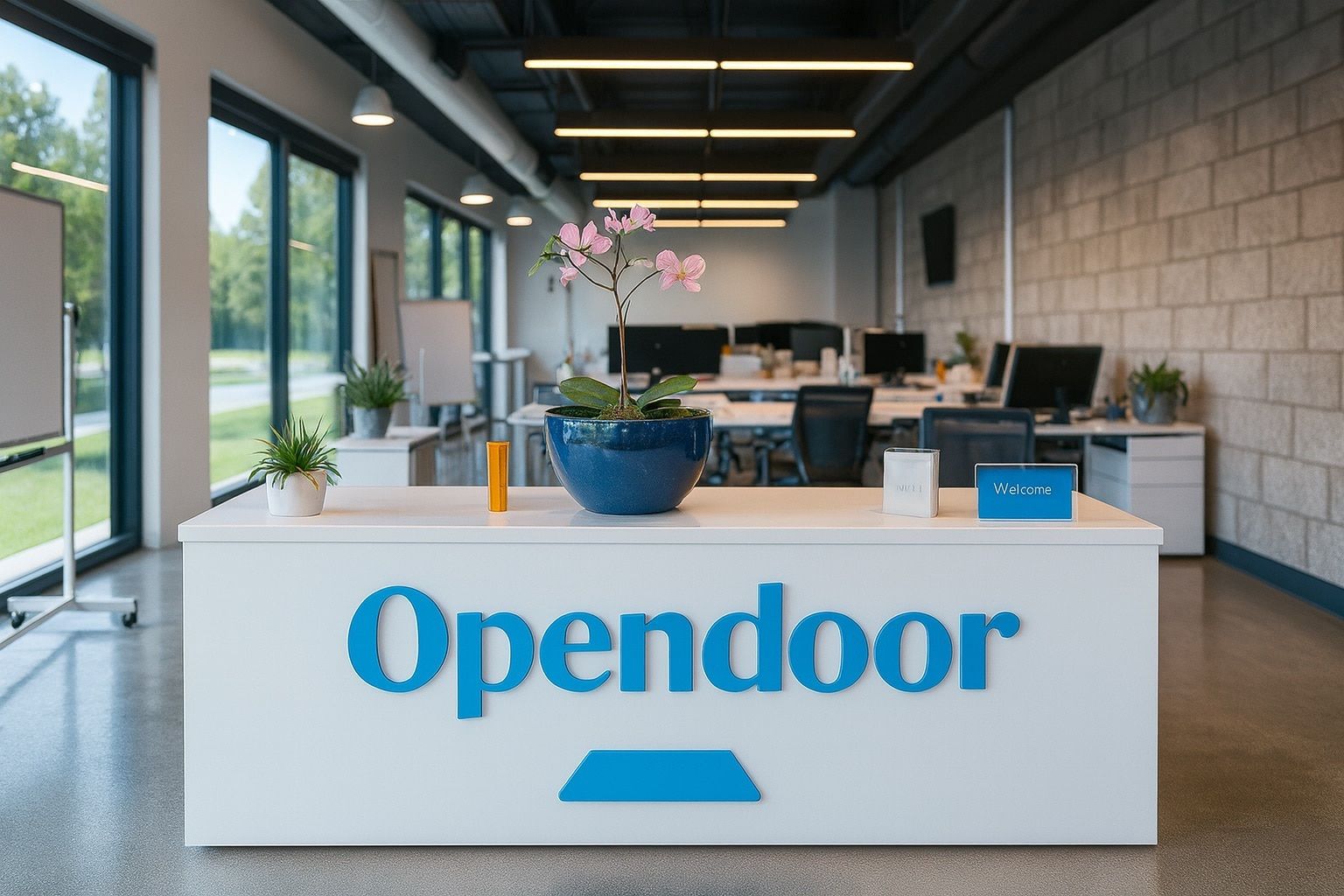- Stock Price Soars: Opendoor Technologies (NASDAQ: OPEN) jumped 13% on Friday (Oct. 24) to close at $7.97, its highest in a week, amid investor optimism about potential Federal Reserve rate cuts [1]. The stock is up roughly 400% year-to-date after a speculative frenzy sent shares from penny-stock levels under $1 in June to a mid-September peak above $10 [2].
- Wild 2025 Rally: Shares have cooled about 30% from that September high but remain far above early-2025 levels [3]. Opendoor’s market capitalization now stands near $6 billion [4] after an epic ~1,600% surge this summer fueled by retail traders and meme-stock enthusiasm.
- Leadership Shake-Up: A dramatic shake-up in September brought in ex-Shopify COO Kaz Nejatian as the new CEO and saw co-founder Keith Rabois return as board chairman [5]. The leadership change triggered an 80% single-day stock spike [6] and was touted as a fresh start to refocus Opendoor as an “AI-first” real estate platform.
- Crypto Pivot & Insider Buys: Opendoor confirmed plans to accept cryptocurrency (e.g. Bitcoin) for home purchases – an initiative CEO Kaz Nejatian hinted at on social media – sparking a 14% stock pop on the news [7]. In a sign of confidence, co-founder Eric Wu recently bought ~300,000 shares at ~$6.65, and the company’s president also snapped up shares on the open market [8].
- Rate Cut Boost: Cooling inflation and the Fed’s first interest rate cut of 2025 have lifted real estate tech stocks broadly [9]. Opendoor – highly sensitive to mortgage rates – rallied as investors bet that cheaper borrowing costs will revive homebuyer demand [10]. Another Fed rate cut is anticipated by the end of October, which could further improve housing market sentiment.
- Analysts Skeptical: Wall Street remains wary despite the rally. The average analyst price target is only around $1–2 (far below the current price) [11], and one hedge fund manager even labeled OPEN “total garbage” with a broken model [12]. Bears argue that flipping homes at scale with thin margins is extremely tough, while bulls note Opendoor’s roughly 1× sales valuation and dominant iBuyer position could pay off if the housing market rebounds [13].
- Big Tests Ahead: Major catalysts loom. Opendoor’s Q3 earnings report on Nov. 6 will show if it can beat sharply lower revenue guidance after a surprise profit last quarter [14]. Additionally, any signals from the Fed’s late-October meeting on rates could sway housing stocks. Experts say the next few quarters will determine whether Opendoor’s turnaround gains traction or fizzles out [15].
Stock Performance and Recent Moves
Opendoor’s stock has been on a whiplash ride in recent days. After drifting lower through mid-October, shares suddenly rebounded late last week on macroeconomic news. On Friday, Oct. 24, OPEN spiked +13.4% to $7.97 – its best level in about a week – following a cooler-than-expected inflation report that fueled optimism for imminent Fed rate cuts [16] [17]. Real estate stocks surged broadly on the prospect of lower borrowing costs, and Opendoor (highly sensitive to interest rates) was a major beneficiary of the rate-cut buzz [18].
This relief rally came after a mid-month pullback. As recently as Oct. 22, Opendoor shares had slid to around $6.82 [19] – roughly 20-30% below their September highs – amid fading meme-stock enthusiasm and five consecutive red trading days. The ebb in retail trader frenzy (the so-called “$OPEN Army” on Reddit) and declining volume led to a healthy technical correction [20]. However, the late-October macro boost reversed a chunk of those losses, underscoring how news-driven and volatile OPEN remains. In the span of one month, the stock has swung from over $10 to the $6–$8 range, reflecting both profit-taking and renewed dip-buying by investors reacting to each headline.
Year-to-date, 2025 has been extraordinary for Opendoor shareholders. The stock started the year under $1 – flirting with penny-stock status – but then skyrocketed in a speculative summer rally. From about $0.50 in June, OPEN exploded to $10.87 by mid-September (+1,600%), briefly making Opendoor one of the year’s top-performing U.S. stocks [21]. Even after pulling back about 30% from that peak, the stock remains up roughly 400% in 2025 [22]. This astonishing run has been attributed to retail trader mania and short-squeeze dynamics often seen in meme stocks. (About 20–25% of Opendoor’s float is sold short, creating rocket fuel for squeezes and sudden reversals [23].) Each burst of enthusiasm – be it a positive company update or macro news like falling mortgage rates – has tended to send OPEN ripping higher, while disappointments have triggered sharp retreats. The result: a stock chart that looks like a roller coaster, delivering eye-popping gains for bold traders but with stomach-churning volatility and elevated risk for investors [24].
New Leadership and Strategic Shifts
A key driver behind Opendoor’s wild ride has been company-specific developments, especially a major changing of the guard in leadership. In September, Opendoor announced that it was bringing back its founders and installing new tech leadership to spearhead a turnaround. Ex-Shopify COO Kaz Nejatian was named the new CEO, replacing Carrie Wheeler, and co-founder Keith Rabois returned as Board Chairman [25]. The shake-up was backed by a $40 million investment from Khosla Ventures and came after pressure from activist investors who were unhappy with the company’s direction [26] [27]. The market’s reaction was euphoric: Opendoor’s stock skyrocketed 80% in a single day on Sept. 11 when the news hit [28], as retail traders cheered the “founder mode” comeback and fresh tech-oriented vision.
New CEO Kaz Nejatian is known for his expertise in e-commerce and AI-driven operations, and Rabois has made it clear that Opendoor will double down on efficiency. “We’re going to return to our roots,” Rabois said, emphasizing plans to cut costs and streamline the bloated organization [29] [30]. He even suggested Opendoor could operate with 85% fewer employees, remarking “There’s no way you need 1,400 employees… We don’t need more than 200” to run this business [31] [32]. That radical stance underscores the new leadership’s intent to impose Silicon Valley-style discipline on a company that was burning cash. In Rabois’s view, Opendoor’s workforce and culture had drifted, and Nejatian – who oversaw big productivity gains at Shopify – is “the right leader to unlock Opendoor’s unique data and assets as an AI-first company” [33].
Beyond internal cuts, Opendoor’s strategy under Nejatian is pivoting to embrace new technology and partnerships. In early October, the CEO hinted that Opendoor will soon allow customers to buy homes using cryptocurrency, responding “We will… just need to prioritize it” when asked about crypto payments [34]. Shortly after, Opendoor confirmed plans to accept Bitcoin and other crypto for home purchases, a move aimed at tech-savvy homebuyers that sent the stock up 14% in one day [35]. This crypto pivot is part public relations play – aligning the brand with buzzy tech trends – and part long-term strategy to modernize real estate transactions. “The crypto-payment plan is meant to modernize homebuying and appeal to new tech-savvy customers,” noted one analyst [36].
The company also isn’t entirely abandoning the traditional real estate ecosystem. Opendoor has started partnering with local agents to help sell its homes (even paying commissions), a notable shift from its earlier go-it-alone approach [37]. By enlisting agents and offering novel services (like 7-day “home test drive” programs), Nejatian aims to blend Opendoor’s tech platform with industry expertise to move houses more efficiently [38] [39]. All these changes – new leadership, tech pivots, and a more collaborative model – have been taken as positive signs by investors hungry for a turnaround story.
Analyst Commentary and Investor Sentiment
Despite the exciting story and triple-digit gains, professional analysts largely remain unconvinced. Wall Street’s consensus on Opendoor is decidedly bearish/cautious, even as retail investors sing the company’s praises. According to Bloomberg and other surveys, the average 12-month analyst price target is only around $1.50 per share, in a range of roughly $0.70 to $6 [40]. In other words, even the highest bullish analyst sees downside from the current ~$8 stock price. Several analysts actually downgraded the stock as it surged – viewing the rally as detached from fundamentals. For example, in August, KBW cut OPEN to Underperform with a mere $1 target, and Citigroup likewise slapped a Sell rating [41]. One hedge fund manager bluntly called Opendoor “total garbage,” arguing its home-flipping model is fundamentally broken and unsustainable [42].
Bears contend that Opendoor’s business of iBuying (algorithmically buying and reselling homes) simply doesn’t work in the long run. It’s an ultra-thin margin, high-risk venture – one that even industry giants Zillow and Redfin couldn’t make profitable and ultimately abandoned [43] [44]. Opendoor has yet to prove it can generate consistent earnings, having lost money in each of the past several years. Skeptics point to the company’s persistent net losses, hefty debt, and share dilution. Even after the stock’s earlier collapse (from a $35 SPAC era high down to under $1), they argue OPEN isn’t “cheap” if the company keeps burning cash. At around $8, Opendoor still commands a multi-billion dollar valuation despite cumulative losses and an uncertain path to profitability [45]. In short, the bear case is that Opendoor’s recent surge is a “meme mirage” – a temporary spike driven by Reddit hype and a brief housing uptick, doomed to fade as reality sets in [46].
On the other side, bullish investors and company insiders see a massive opportunity if Opendoor can execute. Notably, insiders have been buying into the rally: co-founder Eric Wu purchased ~300,752 shares around $6.65 in recent weeks, and President Shrisha Radhakrishna also scooped up shares worth ~$128,000 [47]. Such insider buying is often viewed as a vote of confidence in the company’s future. Meanwhile, some growth-focused analysts highlight that Opendoor, even after soaring, trades at only about 1.1× its trailing revenue – roughly a price-to-sales of 1, which could be considered low for a tech-enabled market leader [48]. Opendoor’s revenue had been growing ~40% annually prior to the housing slump [49], and bulls argue that as the last major iBuyer standing it can capture outsized market share when the housing cycle turns up [50] [51]. “Opendoor dominates the iBuyer niche now that competitors have bowed out,” one optimistic analysis noted, giving it “a second chance to thrive” in a recovering market [52] [53].
Crucially, retail investor sentiment has been a driving force in 2025. Opendoor enjoys a passionate online following – the self-proclaimed “$OPEN Army” on forums like Reddit – that has at times defied traditional valuation logic [54]. This enthusiastic crowd is drawn to Opendoor’s vision of disrupting the antiquated homebuying process, and they’ve shown willingness to HODL through volatility or even buy more on dips. Their fervor, amplified by social media, helped propel the stock’s meme-like rally in the summer [55]. However, as October showed, momentum from the crowd can be fickle: when hype faded, the stock swooned until the next catalyst arrived. The tug-of-war between Reddit bulls and Wall Street bears makes OPEN’s near-term trajectory especially unpredictable. High short interest (over 20% of float [56]) means any positive spark can ignite a squeeze, but it also signals many sophisticated traders are betting on a decline. This dynamic has turned Opendoor into a battleground stock where sentiment can shift rapidly.
Industry Trends and Competitive Landscape
Opendoor’s fortunes are tightly linked to the broader housing market and macroeconomic trends. The past couple of years have been a trial by fire: in 2022-2023, the U.S. housing market flipped from boom to bust as mortgage rates shot up from ~3% to over 7%, the highest in two decades [57] [58]. Affordability cratered, home sales plunged to multidecade lows, and suddenly Opendoor was stuck holding houses that were losing value. Those conditions led to heavy losses for all iBuyers – Zillow famously took a ~$500M write-down and shut its iBuying unit in 2021, and Redfin followed suit in 2022 after bleeding cash [59] [60]. By mid-2023, Opendoor had dramatically scaled back purchases to survive the downturn.
Now, as 2025 nears its end, there are signs the housing cycle may be bottoming out – which is crucial for Opendoor. Inflation has been gradually cooling, allowing the Fed to finally pivot to easing. In September 2025, the Federal Reserve cut interest rates for the first time in this cycle, signaling an end to relentless monetary tightening [61]. Another quarter-point rate cut is widely expected by late October [62]. Mortgage rates, while still high around the mid-6% range, have ticked down slightly from their peak levels [63] [64]. Importantly, homebuying activity is perking up: new home sales spiked +20% in August 2025, as builders offered incentives and buyers adjusted to the “new normal” rates [65] [66]. If these trends continue, 2025 could mark the bottom for housing, with a modest recovery taking hold in 2026.
For Opendoor, such a rebound would be a lifeline. The company’s model requires home prices to at least hold steady (if not rise) during the brief period it holds inventory, and it needs sufficient transaction volume so it can turn over homes quickly. Management has made clear that a sustained housing uptick is key to improving margins and returning to profitability [67] [68]. In a healthier market, Opendoor can sell houses faster and at better prices, boosting its spread on each flip. Conversely, if the economy slips into a recession or if mortgage rates spike again unexpectedly, housing could stall and renew severe pressure on Opendoor’s business [69] [70]. The specter of 2022’s slump still looms in investors’ minds – it showed how quickly an iBuyer’s inventory can turn toxic in a falling market, forcing fire-sales and big write-downs.
In terms of competition, Opendoor now stands in a somewhat lonely position. Both Zillow (NASDAQ: Z) and Redfin (NASDAQ: RDFN) – who once competed in iBuying – shut down those operations after concluding the model was unsustainable for them [71] [72]. Only Offerpad (NYSE: OPAD), a smaller iBuyer founded in 2015, remains in the space alongside Opendoor [73]. Offerpad operates in a limited number of states and carries a much smaller housing inventory, so it’s not a major threat at Opendoor’s scale [74]. This near lack of direct competitors gives Opendoor a chance to capture market share without bidding wars against equally well-funded rivals. In theory, that could help with margins – for example, Opendoor might not need to overpay for homes just to beat a competitor’s offer if it’s often the only instant-bid option for sellers.
However, the absence of big competitors is also a telling sign of how challenging the iBuying model is. Zillow and Redfin’s high-profile failures underscore that even with deep pockets and data prowess, flipping homes at scale can be a money-losing proposition in anything less than ideal market conditions. Opendoor must convince investors that it can succeed where others failed – likely by leveraging better technology (AI-driven pricing, automated renovations, etc.) and far stricter risk management. One strategic tweak already in play is Opendoor’s move to collaborate with traditional agents (paying commissions to agents who bring buyers for Opendoor-owned homes) [75]. This reflects a more pragmatic approach: rather than trying to upend the entire real estate brokerage system, Opendoor is finding ways to work within it to move inventory. How well the company balances being a disruptor versus integrating with the old guard will be an interesting dynamic to watch.
Outlook: High Stakes for the Turnaround
Looking ahead, Opendoor faces a pivotal few months that could chart its course into 2026. In the short term, two catalysts stand out. First is the Federal Reserve’s upcoming meeting (scheduled for Oct. 29, 2025) – another interest rate cut (or hints of future cuts) could further brighten the outlook for housing and give OPEN a sentiment boost. Conversely, any hawkish surprise from the Fed would likely hit housing-sensitive stocks hard. The second and bigger test is Opendoor’s Q3 2025 earnings report on Nov. 6. Investors will scrutinize whether management can deliver results above the low bar it set. The company has already warned that Q3 revenue will plunge ~50% year-over-year (to around $0.8–0.87 billion) and that it will slide back into a loss after eking out a profit in Q2 [76]. Analysts expect about a 36% YoY revenue drop for the quarter [77]. If Opendoor manages to beat these subdued expectations or paints a rosier picture for Q4 and beyond, the stock could rally on relief. Any hint of progress – whether it’s improving margins, a smaller-than-feared loss, or upbeat commentary from the new CEO – might reignite the bull case. On the other hand, if results disappoint (e.g. even weaker revenue or cautious guidance), OPEN could see a harsh pullback as traders quickly sell the news, given the stock’s huge run-up this year.
Beyond this earnings season, the longer-term trajectory of Opendoor will hinge on its execution and whether the housing market cooperates. By 2026, management aims to achieve sustainable profitability (or at least break-even) [78] [79]. Hitting that goal will likely require a combination of factors: continued recovery in housing demand, much higher operational efficiency through tech and cost cuts, and disciplined growth that doesn’t sacrifice margins. There are reasons for optimism. Under Nejatian’s direction, Opendoor is aggressively trimming fat – reducing headcount and overhead – and focusing on an “AI-first, lean” operating model [80] [81]. The company is experimenting with new tools (AI pricing algorithms, automation of home inspections/renovations) and strategies (like the aforementioned agent partnerships and even a trial “Home Test Drive” program for buyers) to boost its conversion rates [82] [83]. If these measures bear fruit, Opendoor could potentially sell homes faster and at better margins, which would go a long way toward turning the financials around. The addressable market remains massive – Americans buy and sell on the order of 5 million+ homes each year, representing trillions of dollars in value. Capturing even a few percent of that transaction volume through its platform would translate into tens of billions in revenue for Opendoor. In a bull case scenario where Opendoor perfects its model and becomes a dominant, profitable digital homebuying platform, some believers argue the stock could have multi-bagger upside from today’s levels.
However, the bear case looms large in the long run as well. Critics argue that Opendoor may never sustainably make money on home flips given the inherent market volatility and razor-thin spreads [84]. Any number of things could derail the turnaround: a resurgence of inflation forcing rates back up, a recession that hits housing demand, or simply the company failing to squeeze out enough efficiency gains even in a decent market. If housing remains sluggish longer than hoped or if Opendoor’s vaunted AI improvements don’t materially boost margins, the company could continue to bleed cash. In that scenario, today’s $7–$8 share price might eventually look like an overvalued relic of meme-stock hype, with OPEN “re-rating” back downward over time [85]. Some analysts warn against the “cheap stock” illusion – just because OPEN traded under $1 before doesn’t guarantee that its new higher price will hold if fundamentals don’t catch up [86]. Notably, trading volume in Opendoor has already cooled from its peak, a sign that the initial frenzy is moderating [87]. If retail interest fades and no real profits emerge, bears see the stock drifting back toward penny-stock territory in the long run.
Bottom Line: Opendoor’s journey in 2025 has been a high-risk, high-reward saga – and the climax is still ahead. The company has shown it can excite the market with bold news and ride macro tailwinds (like rate cuts), but it still needs to prove it has a viable, profitable business underneath the hype. As one co-founder, Keith Rabois, put it, “We’re going to transform the way people buy and sell houses,” and the potential of the company is “infinite” if it succeeds [88]. Yet, skeptics counter that iBuying is simply too tough a nut to crack, and that Opendoor’s recent surge may be as good as it gets. With the stock at a crossroads, the next few quarters will be crucial in determining which narrative wins out [89]. Investors would be wise to tread carefully, stay tuned to key indicators (from Fed policy to home price data to Opendoor’s cash burn), and be prepared for continued volatility. Opendoor has opened the door to a new way of real estate – now it must convince Wall Street it can make that vision work for the long haul.
Sources: Key information and quotes were drawn from TechStock²/ts2.tech’s analysis of Opendoor [90] [91] [92], Insider Monkey and MarketWatch market updates [93], 24/7 Wall St. news on Opendoor’s crypto plans and insider trades [94] [95], Real Estate News interviews with Opendoor’s co-founder [96] [97], and other reputable financial outlets. All data are as of October 27, 2025.
References
1. ts2.tech, 2. ts2.tech, 3. ts2.tech, 4. ts2.tech, 5. ts2.tech, 6. 247wallst.com, 7. ts2.tech, 8. 247wallst.com, 9. ts2.tech, 10. www.insidermonkey.com, 11. ts2.tech, 12. ts2.tech, 13. ts2.tech, 14. ts2.tech, 15. ts2.tech, 16. ts2.tech, 17. www.insidermonkey.com, 18. ts2.tech, 19. ts2.tech, 20. ts2.tech, 21. ts2.tech, 22. ts2.tech, 23. ts2.tech, 24. ts2.tech, 25. ts2.tech, 26. 247wallst.com, 27. www.realestatenews.com, 28. 247wallst.com, 29. www.realestatenews.com, 30. www.realestatenews.com, 31. www.realestatenews.com, 32. www.realestatenews.com, 33. www.realestatenews.com, 34. 247wallst.com, 35. ts2.tech, 36. 247wallst.com, 37. ts2.tech, 38. ts2.tech, 39. ts2.tech, 40. ts2.tech, 41. ts2.tech, 42. ts2.tech, 43. ts2.tech, 44. www.realestatenews.com, 45. ts2.tech, 46. ts2.tech, 47. 247wallst.com, 48. ts2.tech, 49. ts2.tech, 50. ts2.tech, 51. ts2.tech, 52. ts2.tech, 53. ts2.tech, 54. ts2.tech, 55. ts2.tech, 56. ts2.tech, 57. ts2.tech, 58. ts2.tech, 59. ts2.tech, 60. www.realestatenews.com, 61. ts2.tech, 62. ts2.tech, 63. ts2.tech, 64. ts2.tech, 65. ts2.tech, 66. ts2.tech, 67. ts2.tech, 68. ts2.tech, 69. ts2.tech, 70. ts2.tech, 71. ts2.tech, 72. www.realestatenews.com, 73. ts2.tech, 74. ts2.tech, 75. ts2.tech, 76. ts2.tech, 77. ts2.tech, 78. ts2.tech, 79. ts2.tech, 80. ts2.tech, 81. www.realestatenews.com, 82. ts2.tech, 83. ts2.tech, 84. ts2.tech, 85. ts2.tech, 86. ts2.tech, 87. ts2.tech, 88. www.realestatenews.com, 89. ts2.tech, 90. ts2.tech, 91. ts2.tech, 92. ts2.tech, 93. www.insidermonkey.com, 94. 247wallst.com, 95. 247wallst.com, 96. www.realestatenews.com, 97. www.realestatenews.com





